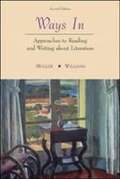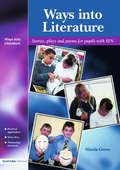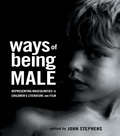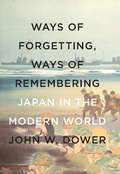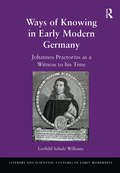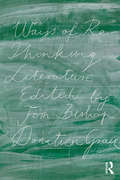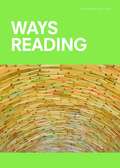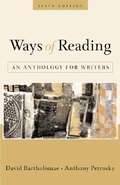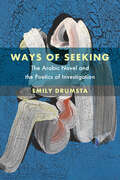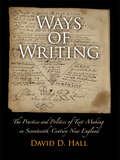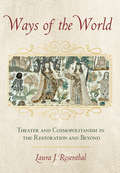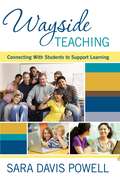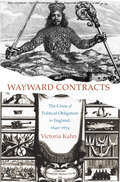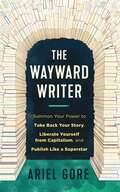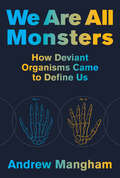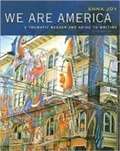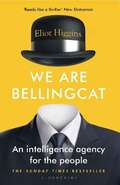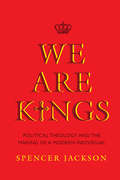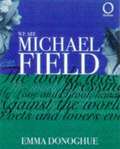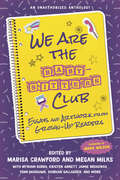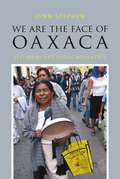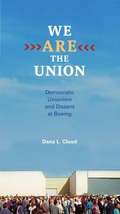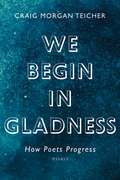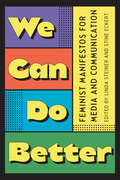- Table View
- List View
Ways In
by Gilbert H. Muller John A. WilliamsBridging the gap between literary and composition theory, Ways In is a concise, integrated guide to critical reading, thinking, and writing about literature.
Ways into Literature: Stories, Plays and Poems for Pupils with SEN
by Nicola GroveBy fostering an emotional engagement with literature, teachers can encourage children to make subsequent critical evaluations. Ways into Literature is in line with current guidelines and will help practitioners get started straight away by using the book's storylines, character maps, and story frames. It will also help practitioners learn from the experiences of real children and fellow practitioners. Ways into Literature contains photocopiable and CD ROM resources.
Ways of Being Male: Representing Masculinities in Children's Literature (Children's Literature and Culture)
by John StephensGiven the substantial impact of feminism on children’s literature and culture during the last quarter century, it comes as no surprise that gender studies have focused predominantly on issues of female representation. The question of how the same patriarchal ideology structured representations of male bodies and behaviors was until very recently a marginal discussion. Now that masculinity has emerges as an overt theme in children’s literature and film, critical consideration of the subject is timely, if not long overdue Ways of Being Male addresses this new concern in an unprecedented collection of essays examining how contemporary debates about masculinity are reflected in fiction and film for young adults. An outstanding team of scholars elucidates the ways in which different versions of male identity are constructed and presented to young audiences. The contributors, drawn from a variety of academic disciplines, employ international discourses in literary criticism, feminism, social sciences, film theory, psychoanalytic criticism, and queer theory in their wide-ranging exploration of male representation. With its illuminating array of perspectives, this pioneering survey brings a long neglected subject into sharp focus.
Ways of Forgetting, Ways of Remembering: Japan in the Modern World
by John W. Dower&“A series of astute academic essays on the forging of postwar Japan&” from the winner of the Pulitzer Prize, National Book Award, and Bancroft Prize (Kirkus Reviews). Remembering and reconstructing the past inevitably involves forgetting—and nowhere more so than in the complex relationship between the United States and Japan since the end of World War II. In this provocative and probing series of essays, John W. Dower—one of our leading historians of postwar Japan and author of the Pulitzer Prize–winning Embracing Defeat—explores the uses and abuses to which this history has been subjected and, with deliberation and insight, affirms the urgent need for scholars to ask the questions that are not being asked. Using E. H. Norman, the unjustly neglected historian of prewar Japan, as a starting point, Ways of Forgetting, Ways of Remembering sets out both to challenge historiographical orthodoxy and reveal the configurations of power inherent in scholarly and popular discourse in Japan and America. It is a profound look at American and Japanese perceptions—past and present—of key moments in their shared history. An incisive investigation of the problems of public history and its role in a modern democracy, these essays are essential reading for anyone interested in postwar US-Japan relations, as well as the broader discipline of history. &“A set of serious, cautionary reflections from a superb historian.&” —Publishers Weekly (starred review)
Ways of Knowing in Early Modern Germany: Johannes Praetorius as a Witness to his Time (Literary and Scientific Cultures of Early Modernity)
by Gerhild Scholz WilliamsGerhild Scholz Williams's Ways of Knowing in Early Modern Germany: Johannes Praetorius as a Witness to His Time, reviews key discourses in eight of Praetorius's works. She introduces the modern reader to the kinds of subjects, the intellectual and spiritual approaches to them, and the genres that this educated and productive German scholar and polymath presented to his audience in the seventeenth century. By relating these individual works to a number of contemporaneous writings, Williams shows how Praetorius constructed a panorama in print in which wonders, the occult, the emerging scientific way of thinking, family and social mores are recurrent themes. Included in Praetorius's portrait of the mid-seventeenth-century are discussions of Paracelsus's scientific theories and practice; early modern German theories on witchcraft and demonology and their applications in the seventeenth century. Furthermore, we read about the early modern beginnings of ethnography, anthropology, and physical geography; gender theory, early modern and contemporary notions of intellectual property, and competing and sometimes conflicting early modern scientific and theological explanations of natural anomalies. Moreover, throughout his work and certainly in those texts chosen for this study, Praetorius appears before us as an assiduous reporter of contemporary European and pan-European events and scientific discoveries, a critic of common superstitions, as much a believer in occult causes and signs and in God's communication with His people. In his writings, in his way of telling, he offers strategies by which to comprehend the political, social, and intellectual uncertainties of his century and, in so doing, identifies ways to confront the diverse interpretive authorities and the varieties of structures of knowledge that interacted and conflicted with each other in the public arena of knowing.
Ways of Re-Thinking Literature
by Donatien Grau Tom BishopWays of Re-Thinking Literature creates a unique platform where leading literary thinkers and practitioners provide a multiplicity of views into what literature is today. The texts gathered in this extraordinary collection range from philosophy to poetry, to theater, to cognitive sciences, to art criticism, to fiction, and their authors rank amongst the most significant figures in their fields, in France, the United States, and the United Kingdom. Topics covered include an assessment of the role of literary narratives in contemporary writing, new considerations on the novel, a redefinition of the "poetic" factor in poetry and life, and a discussion of how literature engages with contemporary forms of individuality. Under the auspices of literary luminaries Hélène Cixous and the late John Ashbery, these new pieces of writing bring to light contributions by innovative and well-established authors from the English-speaking sphere, as well as never-before translated prominent new voices in French theory. Featuring original work from some of today’s most influential authors, Ways of Re-Thinking Literature is an indispensable tool for anybody interested in the future and possibilities of literature as an endeavor for life, thought, and creativity. With special cover artwork by Rita Ackermann, the volume includes contributions from Emily Apter, Philippe Artières, John Ashbery, Paul Audi, Dodie Bellamy, Tom Bishop, Hélène Cixous, Laurent Dubreuil, Tristan Garcia, Stathis Gourgouris, Donatien Grau, Boris Groys, Shelley Jackson, Wayne Koestenbaum, Camille Laurens, Vanessa Place, Maël Renouard, Peter Schjeldahl, Adam Thirlwell, and Camille de Toledo.
Ways of Reading: An Anthology for Writers
by David Bartholomae Anthony Petrosky Stacey WaiteSince its first edition, Ways of Reading has offered a uniquely exciting approach to first-year composition, integrating reading, writing, and critical thinking with a challenging selection of readings and editorial support. By engaging students in conversations with key academic and cultural texts, Ways of Reading helps students develop the intellectual skills necessary for academic work; it also bridges the gap between contemporary critical theory and composition so that instructors can connect their own scholarly work with their teaching. With a mix of shorter, more accessible readings from a broader range of academic disciplines, the eleventh edition offers more flexibility for instructors while continuing to help students become better writers by challenging them to be engaged and critical readers.
Ways of Reading: An Anthology for Writers (6th edition)
by David Bartholomae Anthony PetroskyMuch admired, widely adopted, and one-of-a-kind -- Ways of Reading combines lengthy and challenging readings with an innovative and demanding apparatus to engage students in conversations with some of the most powerful voices of our culture.
Ways of Seeking: The Arabic Novel and the Poetics of Investigation (Islamic Humanities #6)
by Emily DrumstaA free ebook version of this title is available through Luminos, University of California Press’s Open Access publishing program. Visit www.luminosoa.org to learn more. In Ways of Seeking, Emily Drumsta traces the influence of detective fiction on the twentieth-century Arabic novel. Theorizing a "poetics of investigation," she shows how these novels, far from staging awe-inspiring feats of logical deduction, mock the truth-seeking practices on which modern exercises of colonial and national power are often premised. Their narratives return to the archives of Arabic folklore, Islamic piety, and mysticism to explore less coercive ways of knowing, seeing, and seeking. Drumsta argues that scholars of the Middle East neglect the literary at their peril, overlooking key critiques of colonialism from the intellectuals who shaped and responded through fiction to the transformations of modernity. This book ultimately tells a different story about the novel’s place in the constellation of Arab modernism, modeling an innovative method of open-ended inquiry based on the literary texts themselves.
Ways of Writing
by David D. HallWriters abounded in seventeenth-century New England. From the moment of colonization and constantly thereafter, hundreds of people set pen to paper in the course of their lives, some to write letters that others recopied, some to compose sermons as part of their life work as ministers, dozens to attempt verse, and many more to narrate a remarkable experience, provide written testimony to a civil court, participate in a controversy, or keep some sort of records--and of these everyday forms of writing there was no limit.Every colonial writer knew of two different modes of publication, each with its distinctive benefits and limitations. One was to entrust a manuscript to a printer who would set type and impose it on sheets of paper that were bound up into a book. The other was to make handwritten copies or have others make copies, possibly unauthorized. Among the colonists, the terms "publishing" and "book" referred to both of these technologies. Ways of Writing is about the making of texts in the seventeenth century, whether they were fashioned into printed books or circulated in handwritten form. The latter mode of publishing was remarkably common, yet it is much less understood or acknowledged than transmission in print. Indeed, certain writers, including famous ones such as John Winthrop and William Bradford, employed scribal publication almost exclusively; the Antimonian controversy of 1636-38 was carried out by this means until manuscripts relating to the struggle began to be printed in England.Examining printed texts as well as those that were handwritten, David D. Hall explores the practices associated with anonymity, dedications, prefaces, errata, and the like. He also surveys the meaning of authority and authenticity, demonstrating how so many texts were prepared by intermediaries, not by authors, thus contributing to the history of "social" or collaborative authorship. Finally, he considers the political contexts that affected the transmission and publication of many texts, revealing that a space for dissent and criticism was already present in the colonies by the 1640s, a space exploited mainly by scribally published texts.
Ways of the World: Theater and Cosmopolitanism in the Restoration and Beyond
by Laura J. RosenthalWays of the World explores cosmopolitanism as it emerged during the Restoration and the role theater played in both memorializing and satirizing its implications and consequences. Rooted in the Stuart ambition to raise the status of England through two crucial investments—global traffic, including the slave trade, and cultural sophistication—this intensified global orientation led to the creation of global mercantile networks and to the rise of an urban British elite who drank Ethiopian coffee out of Asian porcelain at Ottoman-inspired coffeehouses. Restoration drama exposed cosmopolitanism's most embarrassing and troubling aspects, with such writers as Joseph Addison, Aphra Behn, John Dryden, and William Wycherley dramatizing the emotional and ethical dilemmas that imperial and commercial expansion brought to light.Altering standard narratives about Restoration drama, Laura J. Rosenthal shows how the reinvention of theater in this period—including technical innovations and the introduction of female performers—helped make possible performances that held the actions of the nation up for scrutiny, simultaneously indulging and ridiculing the violence and exploitation being perpetuated. In doing so, Ways of the World reveals an otherwise elusive consistency between Restoration genres (comedy, tragedy, heroic plays, and tragicomedy), disrupts conventional understandings of the rise and reception of early capitalism, and offers a fresh perspective on theatrical culture in the context of the shifting political realities of seventeenth- and eighteenth-century Britain.
Ways with Words: Language, life, and work in communities and classrooms
by Shirley Brice HeathWays with Words is a classic study of children learning to use language at home and at school in two communities only a few miles apart in the south-eastern United States. 'Roadville' is a white working-class community of families steeped for generations in the life of textile mills; 'Trackton' is an African-American working-class community whose older generations grew up farming the land, but whose existent members work in the mills. In tracing the children's language development the author shows the deep cultural differences between the two communities, whose ways with words differ as strikingly from each other as either does from the pattern of the townspeople, the 'mainstream' blacks and whites who hold power in the schools and workplaces of the region. Employing the combined skills of ethnographer, social historian, and teacher, the author raises fundamental questions about the nature of language development, the effects of literacy on oral language habits, and the sources of communication problems in schools and workplaces.
Wayside Teaching: Connecting with Students to Support Learning
by Sara Davis PowellWayside teaching is about intentionally practicing what educators do every day in perhaps unintentional ways: relate to students. This practical, research-based guide illustrates how wayside teaching—the informal curriculum, implicit instruction, and mentoring that happens in sometimes unintentional ways—can be intentionally practiced across grade levels to enhance learning and boost student outcomes. Through a framework focused on attitudes, approaches, and actions, and using vignettes that illuminate wayside teaching in action, Sara Davis Powell demonstrates how reaching out to students in formal and informal situations helps create a culture of belonging and safety that strengthens a student’s self-image, confidence, resiliency, and cognitive processes. Offering invaluable resources, including student surveys for learning more about your students and an annotated booklist for promoting acceptance and compassion, Wayside Teaching reflects the powerful influence that teachers’ actions can have on their students’ academic and personal lives.
Wayward Contracts: The Crisis of Political Obligation in England, 1640-1674
by Victoria KahnWhy did the language of contract become the dominant metaphor for the relationship between subject and sovereign in mid-seventeenth-century England? In Wayward Contracts, Victoria Kahn takes issue with the usual explanation for the emergence of contract theory in terms of the origins of liberalism, with its notions of autonomy, liberty, and equality before the law. Drawing on literature as well as political theory, state trials as well as religious debates, Kahn argues that the sudden prominence of contract theory was part of the linguistic turn of early modern culture, when government was imagined in terms of the poetic power to bring new artifacts into existence. But this new power also brought in its wake a tremendous anxiety about the contingency of obligation and the instability of the passions that induce individuals to consent to a sovereign power. In this wide-ranging analysis of the cultural significance of contract theory, the lover and the slave, the tyrant and the regicide, the fool and the liar emerge as some of the central, if wayward, protagonists of the new theory of political obligation. The result is must reading for students and scholars of early modern literature and early modern political theory, as well as historians of political thought and of liberalism.
Wayward Writer, The: Summon Your Power to Take Back Your Story, Liberate Yourself from Capitalism, and Publish Like a Superstar
by Ariel GoreWhen your dream and creative passion is to write, how do you succeed without selling out or selling yourself short? Ariel Gore has spent her life trying to solve this puzzle, writing and organizing her way towards a creative utopian vision, where storytelling is a form of resistance and writing is an outsider art. In this follow-up to her national bestseller How to Become a Famous Writer Before You're Dead, Gore offers a lyrical call to literary revolution paired with practical exercises. Through her own experiences and interviews with other authors, publishers, and agents, she shows you how to chart your own creative education, vanquish shame and imposter syndrome, cast off oppression, cast a spell on your readers, step into your unique powers, and build your own literary community where respect and honesty reign and where you can be a writer and survive. Gore presents an alternative narrative structure to the patriarchal hero's journey, with a focus on tapping into myths and hidden places. She urges us to not be precious about where or when we write, or to apologize for who and what we are, or to stop short of telling the truth about our lives. The result is an impossible to ignore rallying cry for writing dangerously to create a liberatory literary utopia and a helpful guide through the thorny landscape of publishing your work.
We Are All Monsters: How Deviant Organisms Came to Define Us
by Andrew ManghamHow the monsters of nineteenth-century literature and science came to define us.&“Was I then a monster, a blot upon the earth, from which all men fled and whom all men disowned?&” In We Are All Monsters, Andrew Mangham offers a fresh interpretation of this question uttered by Frankenstein&’s creature in Mary Shelley&’s 1818 novel in an expansive exploration of how nineteenth-century literature and science recast the monster as vital to the workings of nature and key to unlocking the knowledge of all life-forms and processes. Even as gothic literature and freak shows exploited an abiding association between abnormal bodies and horror, amazement, or failure, the development of monsters in the ideas and writings of this period showed the world to be dynamic, varied, plentiful, transformative, and creative.In works ranging from Comte de Buffon&’s interrogations of humanity within natural history to Hugo de Vries&’s mutation theory, and from Shelley&’s artificial man to fin de siècle notions of body difference, Mangham expertly traces a persistent attempt to understand modern subjectivity through a range of biological and imaginary monsters. In a world that hides monstrosity behind theoretical and cultural representations that reinscribe its otherness, this enlightened book shows how innovative nineteenth-century thinkers dismantled the fictive idea of normality and provided a means of thinking about life in ways that check the reflexive tendency to categorize and divide.
We Are America: A Thematic Reader and Guide to Writing, Sixth Edition
by Anna JoyThe book introduces you to the writing process, basic reading skills, and the essential elements of effective writing. Inside are writing samples from college students.
We Are Bellingcat: Global Crime, Online Sleuths, and the Bold Future of News
by Eliot HigginsTHE SUNDAY TIMES BESTSELLER <p><p> 'John le Carré demystified the intelligence services; Higgins has demystified intelligence gathering itself' Financial Times <p><p> 'Uplifting . . . Riveting . . . What will fire people through these pages, gripped, is the focused, and extraordinary investigations that Bellingcat runs . . . Each runs as if the concluding chapter of a Holmesian whodunit' Telegraph <p><p> 'We Are Bellingcat is Higgins's gripping account of how he reinvented reporting for the internet age . . . A manifesto for optimism in a dark age' Luke Harding, Observer <p><p> How did a collective of self-taught internet sleuths end up solving some of the biggest crimes of our time? <p><p> Bellingcat, the home-grown investigative unit, is redefining the way we think about news, politics and the digital future. Here, their founder - a high-school dropout on a kitchen laptop - tells the story of how they created a whole new category of information-gathering, galvanising citizen journalists across the globe to expose war crimes and pick apart disinformation, using just their computers. <p><p> From the downing of Malaysia Flight 17 over the Ukraine to the sourcing of weapons in the Syrian Civil War and the identification of the Salisbury poisoners, We Are Bellingcat digs deep into some of Bellingcat's most successful investigations. It explores the most cutting-edge tools for analysing data, from virtual-reality software that can build photorealistic 3D models of a crime scene, to apps that can identify exactly what time of day a photograph was taken. <p><p> In our age of uncertain truths, Bellingcat is what the world needs right now - an intelligence agency by the people, for the people.
We Are Kings: Political Theology and the Making of a Modern Individual
by Spencer JacksonWhen British and American leaders today talk of the nation—whether it is Boris Johnson, Barack Obama, or Donald Trump—they do so, in part, in terms established by eighteenth-century British literature. The city on a hill and the sovereign individual are tropes at the center of modern Anglo-American political thought, and the literature that accompanied Britain’s rise to imperial prominence played a key role in creating them. We Are Kings is the first book to interpret eighteenth-century British literature from the perspective of political theology. Spencer Jackson returns here to a body of literature long associated with modernity’s origins without assuming that modernity entails a separation of the religious from the profane. The result is a study that casts this literature in a surprisingly new light. From the patriot to the marriage plot, the narratives and characters of eighteenth-century British literature are the products of the politicization of religion, Jackson argues; the real story of this literature is neither secularization nor the survival of orthodox Judeo-Christianity but rather the expansion of a movement beginning in the High Middle Ages to transfer the transcendent authority of the Catholic Church to the English political sphere. The novel and the modern individual, then, are in a sense both secular and religious at once—products of a modern political faith that has authorized Anglo-American exceptionalism from the eighteenth century to the present.
We Are Michael Field
by Emma DonoghueThe story of two eccentric Victorian spinsters, Katherine Bradley and her niece Edith Cooper, poets and lovers, who wrote together under the name Michael Field.
We Are the Baby-Sitters Club: Essays and Artwork from Grown-Up Readers
by Megan Milks Mara Wilson Marisa Crawford"More than a book about a series of books, it is an ode to the child readers we were, and the ways we have learned to name the experiences we couldn't find written." —Melissa Febos, author of Abandon Me & Girlhood A nostalgia-packed, star-studded anthology featuring contributors such as Kristen Arnett, Yumi Sakugawa, Gabrielle Moss, and others exploring the lasting impact of the beloved Baby-Sitters Club series In 1986, the first-ever meeting of the Baby-Sitters Club was called to order in a messy bedroom strewn with Ring-Dings, scrunchies, and a landline phone. Kristy, Claudia, Stacey, and Mary Anne launched the club that birthed an entire generation of loyal readers. The Baby-Sitters Club series featured a diverse, complex cast of characters and touched on an impressive range of issues that were underrepresented at the time: divorce, adoption, childhood illness, class division, and racism, to name a few. In We Are the Baby-sitters Club, writers and a few visual artists from Generation BSC will reflect on the enduring legacy of Ann M. Martin's beloved series, thirty-five years later—celebrating the BSC's profound cultural influence. Contributors include author Gabrielle Moss, illustrator Siobhán Gallagher, and filmmaker Sue Ding, as well as New York Times bestselling author Kristen Arnett, Lambda Award–finalist Myriam Gurba, Black Girl Nerds founder Jamie Broadnax, and Paris Review contributor Frankie Thomas.The first anthology of its kind from editors Marisa Crawford and Megan Milks, We Are the Baby-Sitters Club will look closely at how Ann M. Martin's series shaped our ideas about gender politics, friendship, fashion and beyond—and what makes the series still a core part of many readers' identities so many years later.
We Are the Face of Oaxaca: Testimony and Social Movements
by Lynn StephenA massive uprising against the Mexican state of Oaxaca began with the emergence of the Popular Assembly of the Peoples of Oaxaca (APPO) in June 2006. A coalition of more than 300 organizations, APPO disrupted the functions of Oaxaca's government for six months. It began to develop an inclusive and participatory political vision for the state. Testimonials were broadcast on radio and television stations appropriated by APPO, shared at public demonstrations, debated in homes and in the streets, and disseminated around the world via the Internet. The movement was met with violent repression. Participants were imprisoned, tortured, and even killed. Lynn Stephen emphasizes the crucial role of testimony in human rights work, indigenous cultural history, community and indigenous radio, and women's articulation of their rights to speak and be heard. She also explores transborder support for APPO, particularly among Oaxacan immigrants in Los Angeles. The book is supplemented by a website featuring video testimonials, pictures, documents, and a timeline of key events.
We Are the Union: Democratic Unionism and Dissent at Boeing
by Dana L. CloudIn this extraordinary tale of union democracy, Dana L. Cloud engages union reformers at Boeing in Wichita and Seattle to reveal how ordinary workers attempted to take command of their futures by chipping away at the cozy partnership between union leadership and corporate management. Taking readers into the central dilemma of having to fight an institution while simultaneously using it as a bastion of basic self-defense, We Are the Union offers a sophisticated exploration of the structural opportunities and balance of forces at play in modern unions told through a highly relevant case study. Focusing on the 1995 strike at Boeing, Cloud renders a multi-layered account of the battles between company and the union and within the union led by Unionists for Democratic Change and two other dissident groups. She gives voice to the company's claims of the hardships of competitiveness and the entrenched union leaders' calls for concessions in the name of job security, alongside the democratic union reformers' fight for a rank-and-file upsurge against both the company and the union leaders. We Are the Union is grounded in on-site research and interviews and focuses on the efforts by Unionists for Democratic Change to reform unions from within. Incorporating theory and methods from the fields of organizational communication as well as labor studies, Cloud methodically uncovers and analyzes the goals, strategies, and dilemmas of the dissidents who, while wanting to uphold the ideas and ideals of the union, took up the gauntlet to make it more responsive to workers and less conciliatory toward management, especially in times of economic stress or crisis. Cloud calls for a revival of militant unionism as a response to union leaders' embracing of management and training programs that put workers in the same camp as management, arguing that reform groups should look to the emergence of powerful industrial unions in the United States for guidance on revolutionizing existing institutions and building new ones that truly accommodate workers' needs. Drawing from communication studies, labor history, and oral history and including a chapter co-written with Boeing worker Keith Thomas, We Are the Union contextualizes what happened at Boeing as an exemplar of agency that speaks both to the past and the future.
We Begin in Gladness: How Poets Progress
by Craig Morgan TeicherOne of our most perceptive critics on the ways that poets develop poems, a career, and a lifeThough it seems, at first, like an art of speaking, poetry is an art of listening. The poet trains to hear clearly and, as much as possible, without interruption, the voice of his or her mind, the voice that gathers, packs with meaning, and unpacks the language he or she knows. It can take a long time to learn to let this voice speak without getting in its way. This slow learning, the growth of this habit of inner attentiveness, is poetic development, and it is the substance of the poet’s art. Of course, this growth is rarely steady, never linear, and is sometimes not actually growth but diminishment—that’s all part of the compelling story of a poet’s way forward. —from the Introduction“The staggering thing about a life’s work is it takes a lifetime to complete,” Craig Morgan Teicher writes in these luminous essays. We Begin in Gladness considers how poets start out, how they learn to hear themselves, and how some offer us that rare, glittering thing: lasting work. Teicher traces the poetic development of the works of Sylvia Plath, John Ashbery, Louise Glück, and Francine J. Harris, among others, to illuminate the paths they forged—by dramatic breakthroughs or by slow increments, and always by perseverance. We Begin in Gladness is indispensable for readers curious about the artistic life and for writers wondering how they might light out—or even scale the peak of the mountain.
We Can Do Better: Feminist Manifestos for Media and Communication
by Meenakshi Gigi Durham Carolyn Kitch Lori Kido Lopez Linda Steiner Sahar Khamis Kim Hong Nguyen Summer Harlow Dafna Lemish Dustin Harp Stine Eckert Miglena Sternadori Eve Ng Gina M. Masullo Frieda Werden Denetra Walker Erin L. Perry Carolina Velloso Katy Fulfer Jade Metzger-Riftkin Amara Imari SugalskiFeminist Manifestos for Media and Communication brings together evidence-based manifestos for media and communication that take a feminist perspective and add up to a provocative vision of feminist media practices and of feminist communication. The book discusses critical problems and complaints in ways that identify and make the case for actionable, concrete solutions to media problems and deficiencies; it shows how feminist thinking can be usefully and effectively applied to a wide range of journalism, media, and communication practices. The manifestos are not “only” about women but rather offer specific, feasible blueprints for restructuring media in ways that make them fairer and more equitable along many vectors of identity, so that media can better serve democracy. These manifestos give concrete solutions to specific problems that can and should be implemented by journalists, media practitioners, students, faculty, and scholars. The manifestos are organized around three sets of demands: for better media practices, for more participatory online spaces, and for more precise and appropriate language.
